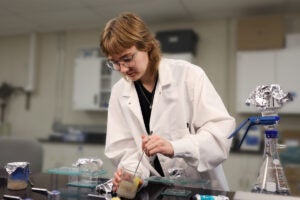AUSTIN, Texas —An international astronomy team, including Dr. John Kormendy, an astronomy professor at The University of Texas at Austin, has discovered eight new supermassive black holes, revealing important new clues to the process of galaxy formation.
The discoveries will bring the total number of black holes so far found in the universe to at least 33. The findings are being presented on Tuesday (June 6) at the 196th meeting of the American Astronomical Society in Rochester, N.Y.
The team includes Kormendy, who holds the Curtis T. Vaughan, Jr. Centennial Chair in Astronomy at UT Austin’s department of astronomy, Dr. Karl Gebhardt, a Hubble post-doctoral fellow at the University of California at Santa Cruz, Dr. Douglas Richstone, a professor of astronomy at the University of Michigan department of astronomy and an international team of collaborators.
“With the new black hole findings, we have left the ÔGee whiz!’ discovery phase of this subject and entered the phase of doing science with supermassive black holes,” Kormendy said. “In the early days of the search, from the late 1980s through the mid-1990s, all the emphasis was on finding out whether these black holes really exist.”
Black holes are celestial bodies that are so compressed their surface gravity is strong enough to keep even light from escaping. Some black holes have masses several times the mass of the Earth’s Sun. These black holes are formed when massive stars die.
Supermassive black holes, in contrast, are a million to a billion times the mass of the Sun and are found at the centers of galaxies.
Because they are invisible, scientists can only detect and study black holes by observing the movements and velocities of the stars swirling around them. The first supermassive black hole was discovered in 1984, although astrophysicists for years had been predicting black holes based on their theories of how the galaxies operate.
“Supermassive black holes were predicted by our theory of what powers quasars, the brightest objects in the universe. An enormous amount of work on quasars had been done,” Kormendy said. “But an important piece of the puzzle was missing. Nobody was sure that supermassive black holes really exist.”
Kormendy started his search in 1985 and discovered the second, third and fourth supermassive black holes while observing at the Canada-France-Hawaii Telescope on Mauna Kea, Hawaii.
Since then, new discoveries have been made at a rate of one or two per year. The discoveries being announced at the Rochester AAS meeting are the result of 18 months of data collected by the new Space Telescope Imaging Spectrograph on the Hubble Space Telescope. In addition, analysis methods have improved and measurements have become more accurate.
Kormendy said that at least six new black holes have been discovered by other scientific teams, and more may be announced at the American Astronomical Society meeting.
“Suddenly the number of black holes available to us has doubled. This has happened, basically, in the last few weeks as people, including our team, rushed to prepare for this meeting,” Kormendy said. “The new spectrograph is a much more efficient way to look for black holes. Many people have been gearing up to find them.”
With 33 black holes available for research, scientists have enough material to develop a much clearer picture of how galaxies form and how black holes grow. For example, the latest discoveries reveal a fundamental new correlation between black hole mass and galaxy formation, as measured by the random velocities of stars.
Galaxies exist in two basic forms, with variations. Kormendy explained that there are disk or Frisbee-shaped galaxies, such as the Milky Way, and denser, rounder galaxies bulging like partially deflated beach balls. Black holes appear to be closely connected with the properties of the elliptical or bulge-shaped galaxies, but pure disk galaxies do not seem to contain supermassive black holes. The properties of black holes suggest that they grow to their present sizes as part of the galaxy formation process.
Note to editors: For more information, contact UT Austin’s Dr. John Kormendy from June 5-8 at the American Astronomical Society press room (716) 454-2411 and (716) 454-2412 or at UT Austin at (512) 471-8191, or contact Gary Harrison, editor of StarDate Magazineand press officer for the McDonald Observatory at (512) 471-5285. Dr. Kormendy’s Website is http://chandra.as.utexas.edu/~kormendy/. The StarDateWebsite is http://www.stardate.utexas.edu. For images, contact Marsha Miller at (512) 471-3151 or see http://hubble.stsci.edu/.



